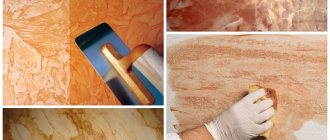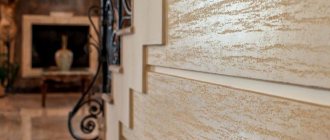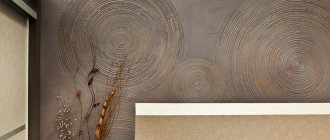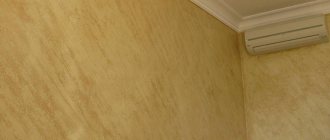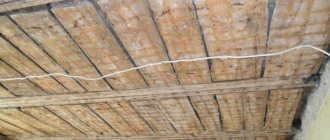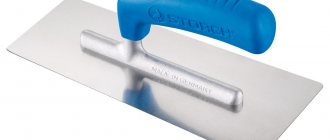Currently, decorative plaster finishing has become especially popular, imitating natural stones, Venetian or Moroccan plaster, giving the interior luxury, majesty and nobility.
Wax for plaster is used for the final stage of finishing: adding shine, color shades, protecting the surface from moisture and other external influences during operation.
Features and purpose
Wall wax can be used in conjunction with various types of plasters - regular finishing plasters, Venetian plasters, bark beetle plasters, and fleece plasters. The main purpose of its application is to create a water-repellent coating on plaster, which itself is prone to absorbing moisture. In addition to enhancing the moisture resistance of the finish, the product also performs other functions:
- extends the service life of plaster;
- improves appearance;
- gives matte or gloss;
- allows you to change the color of the base.
Coating with wax improves the appearance of decorative plaster.
Using wax, you can create interesting tonal transitions on the wall, make a drawing, and change the texture of the finish. The compositions are made on the basis of acrylic copolymers, natural waxes, various modifiers and fillers. Due to the absence of harmful components, they can be used in any room, even in children's rooms. In addition, the products are vapor-permeable and do not disturb the natural air exchange in the house, so a healthy microclimate will remain.
What is the material
Beeswax is originally a natural substance for which humanity has found many areas and methods of application. It smells good, does not allow moisture to pass through and can add shine to the surface. It is used in finishing works as a coating for decorative plaster.
In fact, everything is not as simple as it might seem. Wax for plaster should not be separate from it and simply lie on it, repeating its shape. It is applied to emphasize the texture, give the plaster an antique effect, tint or decorate the surface with various patterns. It should become a protective film of the plaster composition, and after its application no changes will be made. Therefore, you need to approach the choice of wax materials with special responsibility.
Types of compositions
Wax for plaster can be natural or synthetic. We are talking about its base: in natural materials, its role is played by beeswax or palm wax, which gives the finish a unique shine. Such compositions are hypoallergenic, but have a shorter service life than artificial ones. The latter are produced industrially from safe components. Synthetic products are practically impervious to moisture, temperature changes, wear-resistant and do not require frequent renewal of the layer.
Art Wax Optimist for Venetian plaster
Depending on the structure, all waxes can be divided into:
- liquid - easy to apply with a brush, quickly fills even the smallest pores of the base, ideal for highly porous, rough surfaces;
- thick - more suitable for smooth materials, for example, plaster with imitation marble, granite.
Depending on the color scheme, wax for Venetian plaster can also be chosen from a variety of options. Here are their main types:
- Transparent. They provide the finish with shine, a beautiful gloss, or give a soft silky effect. Usually used on plaster that has already been complexly painted or “stone”.
- Colored. They help change the tone of the base itself or color a colorless coating. Compositions of different brands are available in rich color variations.
- With decorative admixtures. The most popular are waxes with gold or silver dust. They are used to imitate gilding, silvering, and to give the coating a beautiful metallic sheen.
Colorless wax composition for walls
Choosing wax for different surfaces
When purchasing a waxing product, you should pay attention to its compliance with the specific type of plaster in terms of performance characteristics. For example, Venetian is applied in several layers, giving it a special stone or antique appearance. Wax should only highlight the beauty of the walls, and not drown it out, so in this case it is worth choosing a transparent composition with moderate shine.
Dull, monochromatic coatings with a matte texture can be decorated using wax with bronze dust or gold plating. The same effects are ideal when applying Moroccan plaster. There are compositions specifically designed for decorating walls in a vintage style - they give them a cracked look, working like craquelure varnish. When choosing wax for the bathroom, kitchen, toilet, you need to pay attention to moisture resistance - the indicator should be maximum.
Decorative plaster coated with wax and gilded
How can I delete
Removal of the layer is required if there are serious defects and the need for periodic renewal of the coating. The complexity of the work depends on what stage the wax is at. If it has not yet hardened, you can remove it on your own.
The soft coating is washed off with a cloth soaked in hot water. Hardened wax can be removed using white spirit solvent. It removes soil compounds from the tree. Before starting cleaning, the method is tested on an inconspicuous area of the wall in the corner below. It is not recommended to work with a large area at once. Make sure that the solvent does not affect the base coat of the surface.
Warm water and cloth treatments are more commonly used for acrylic products. If you remove part of the natural wax or material with the addition of natural components in this way, the surface will stand out after re-application.
Treated walls cannot be washed earlier than 14 days! As a last resort, do not use aggressive detergents.
Wax is removed from Venice in another way. To do this, use fine-grained sandpaper. It is important to remove the film evenly from the entire surface. Then you should remove small particles and any dust that appears. The wall is immediately re-treated, glossed and waxed.
Cost and quality
The price of the product greatly depends on the manufacturer and the components included in the composition. It can be 400-5500 rubles per liter. For example, waxing material from the Russian brand “VGT” costs 450 rubles/liter, Swedish Parade Ice Venezia Wax costs about 1,100 rubles, and Cera di Veneziano material costs 5,450 rubles.
Protective wax Parade Ice Venezia Wax
You should not buy waxes that are too cheap - they may be of poor quality and therefore will not last long. Normally, the coating should be renewed once every 4-5 years, and low-grade compounds sometimes lose their attractiveness and protective properties after just a year. Also, when purchasing, you need to pay attention to environmental friendliness and the absence of allergic components in the composition.
Waxing process
Before working with the product, you must carefully prepare the surface with the plaster applied to it (the latter must be completely dry). Remove dust from the base, preferably using a vacuum cleaner. The plaster should not have holes or other defects - after completing the wax layer it will be impossible to correct them.
Liquid compositions can be applied with a soft flannel cloth or cloth napkin; for thick ones, you should purchase a rubber spatula. It is necessary to immediately buy a sufficient amount of base material: its consumption is 50-80 g/sq.m. m per layer.
Applying a thick composition using a spatula
. Wax that is too thick can be diluted a little with water by preheating it near a radiator or in a water bath. It is important that the volume of water does not exceed 3% of the base. The composition is applied more softly and pliably to the primed plaster, and priming is also carried out using wax (4 parts of water are added to 1 part). The primer must be allowed to dry thoroughly.
Application and polishing
The wax is applied so that its layer rises slightly above the surface and fills all the depressions and holes in the plaster. Do this continuously: then all areas will be evenly colored. A beginner should invite an assistant to wax large surfaces. It is better to apply the product from the corner, moving along the wall.
After application, rub the composition over the base with a slightly damp sponge, and then rub in with a soft cloth until shine appears. Excess unabsorbed product is immediately washed off. If the technique involves tinting the cracks with dark wax, on the contrary, they do not touch the composition that filled them: then the relief will be more distinct. To enhance shine, polish the walls with a sanding machine with a special attachment. The wax drying time is 12-14 hours, complete drying occurs after 7 days.
Polishing Venetian plaster
Error correction
It happens that the composition is applied unevenly, and stripes and spots become noticeable on the surface. It is advisable to correct the mistake immediately, while the material has not yet set. It is enough to moisten a cloth with water, remove excess or add a little wax, and then polish the surface.
Sometimes flaws are noticed later, after 4-7 hours, when the wax is already partially hardened. In this case, you should warm up the problem area with a hairdryer, wet a cloth with hot water and wipe the wall. To remove dense hardened deposits, you can use a solvent. If wax has accumulated in the inner corners of the walls, it is permissible to wrap a white rag around the putty knife and sand these areas again.
How to remove the wax layer
A layer of product that is too thick and has not yet hardened can be washed off with regular hot water using a soft cloth.
Difficult areas are wiped with white spirit or another solvent. Dried wax is removed by sanding with fine-grained sandpaper using a sanding machine or sponge. Then remove dust and remaining composition with a vacuum cleaner.
Error resolution methods
With a lack of experience working with wax, errors occur. These are unevenness and other visual effects resulting from improper application. They can be fixed. The chances of success depend on when the error is noticed:
- the layer has not hardened;
- 5-7 hours passed, and he managed to seize.
The first option is not scary. Errors can be easily corrected. If applied unevenly, the unevenness can be easily corrected with a dampened cloth. The choice of liquid depends on the composition of the wax. Natural materials are worked with water, synthetic ones are treated with a special solvent. Excess is removed; if there is a deficiency, the substance is added to unfilled areas.
If 5 hours have passed since application, the correction will require more effort. The place where the mistake was made is heated. Wet the cloth with heated water and treat the surface. If after drying the wall does not shimmer enough, it is treated with a sander.
If the errors are obvious and there is no experience in correcting them, the layer is washed off. Once dry, it is especially difficult to smooth out uneven surfaces or add shine. Therefore, upon completion of work, you should immediately check its quality.
DIY wax recipe
High-quality products are quite expensive, and it is not always possible to decorate the entire room with them. In this case, there is the option of making your own composition for finishing the plaster.
Soap based wax
This product is prepared from ordinary toilet soap. A 150 g piece is planed on a grater with large holes, then poured with 7 liters of boiling water and brought until completely dissolved. Separately, dilute 2 teaspoons of soda in a small amount of water and add to the soap solution. Whisk the mixture and leave until it cools. Afterwards the wax is ready for application.
The wax composition can be prepared from soap and soda
Composition based on natural wax
You need to prepare the following ingredients:
- 2 parts beeswax (can be replaced with paraffin);
- 1 part purified turpentine;
- 1 part flaxseed oil;
- any pigments (if needed).
The wax is cut and melted in a water bath. Add the remaining components, use a whisk to make the mixture homogeneous, allow to cool and use as intended.
Beeswax for preparing a natural protective composition
Wax based wallpaper glue
Wallpaper glue is diluted in advance according to the instructions. Leave it for half an hour, strain to eliminate the presence of lumps. Add 1 part acrylic varnish and ½ part any decorative paint to 2 parts glue. Mix the composition well and apply it to the plaster like regular wax. If the finish is planned to be colorless, paint may not be added.
Tinting
Craftsmen prefer transparent compositions; they reveal the texture of the plaster. Golden yellow tones with an aging effect are less often chosen.
If the base does not have pronounced decorative qualities, you can change the color tone of the wax layer. They use water-based colors - suitable for all acrylic compositions.
Painting
The volume of the coloring component differs in color. To create veins, silver and gold leaf are added. But after drying, the wax becomes lighter, so first it is applied to an inconspicuous part of the wall to evaluate the result.
How to replace wax composition
You should not leave the plaster without a finishing coat, especially in damp rooms. She will not receive proper protection and will not acquire the most attractive appearance. If applying wax is not possible for any reason, it can be replaced with varnish. The latter performs similar functions:
- preserves the beauty of the finish and the brightness of the colors for a long time;
- protects against the influence of negative factors;
- protects from getting wet;
- provides shine.
Acrylic finishing varnish MelStrom for decorative coatings
Typically, water-based acrylic varnishes are used for processing plaster. They are environmentally friendly and suitable for interior work.
It is important that the composition is vapor-permeable and moisture-resistant, otherwise it will not last long and will disturb the microclimate in the house. Most varnishes dry in 3 hours. They can be not only glossy, but also matte, and are also sold in colored versions, with a metallic sheen and other additives.
Wax reviews
According to the masters, the advantages of wax are difficult to overestimate. After waxing, the surfaces look expensive and elegant. With the right color selection, the room will be even more stylish and attractive. In reviews, users note that after applying wax, walls do not deteriorate from water or constantly high air humidity. Housewives like that it is easy to care for such surfaces - they can simply be washed with a cloth.
Having chosen decorative plaster for finishing your house, you should immediately think about protecting it and applying the finishing coat. Ideally, it would be wax: this material is very beautiful, reliable and lasts for many years!
What is the best way to wash off and remove the wax layer from the wall and other surfaces?
If there is a need to remove decorative plaster, this can be done using warm water or a solvent. It is most convenient to use a cloth for these purposes. It is best to remove the composition with a solution designed for removing primer from wooden surfaces.
Experienced craftsmen do not advise, without having experience, to process the entire wall at once. It is best to practice application on a small area that is not noticeable. If the result is satisfactory, you can proceed to the rest of the wall area.
If the surface has already dried, then removing the wax layer is quite difficult. It can be removed using fine-grained sandpaper or a sanding machine. In this case, cleaning should be done very carefully. Dust is removed from the surface of the entire wall using a vacuum cleaner.
